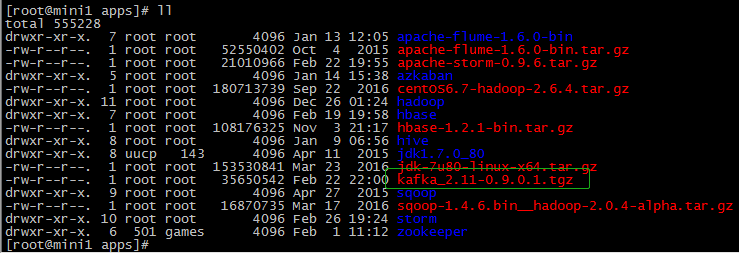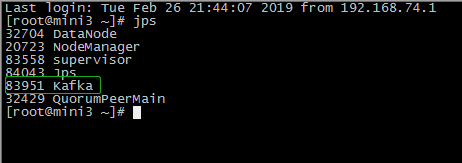大数据学习——Kafka集群部署
1下载安装包


2解压安装包
tar -zxvf kafka_2.-0.9.0.1.tgz mv kafka_2.-0.9.0.1 kafka
3修改配置文件
cp server.properties server.properties.bak
# Licensed to the Apache Software Foundation (ASF) under one or more
# contributor license agreements. See the NOTICE file distributed with
# this work for additional information regarding copyright ownership.
# The ASF licenses this file to You under the Apache License, Version 2.0
# (the "License"); you may not use this file except in compliance with
# the License. You may obtain a copy of the License at
#
# http://www.apache.org/licenses/LICENSE-2.0
#
# Unless required by applicable law or agreed to in writing, software
# distributed under the License is distributed on an "AS IS" BASIS,
# WITHOUT WARRANTIES OR CONDITIONS OF ANY KIND, either express or implied.
# See the License for the specific language governing permissions and
# limitations under the License.
# see kafka.server.KafkaConfig for additional details and defaults ############################# Server Basics ############################# # The id of the broker. This must be set to a unique integer for each broker.
broker.id= zookeeper.connect=mini1:,mini2:,mini3:
############################# Socket Server Settings ############################# #listeners=PLAINTEXT://:9092 # The port the socket server listens on
port= # Hostname the broker will bind to. If not set, the server will bind to all interfaces
host.name=mini1 # Hostname the broker will advertise to producers and consumers. If not set, it uses the
# value for "host.name" if configured. Otherwise, it will use the value returned from
# java.net.InetAddress.getCanonicalHostName().
advertised.host.name=192.168.74.100 # The port to publish to ZooKeeper for clients to use. If this is not set,
# it will publish the same port that the broker binds to.
advertised.port= # The number of threads handling network requests
num.network.threads= # The number of threads doing disk I/O
num.io.threads= # The send buffer (SO_SNDBUF) used by the socket server
socket.send.buffer.bytes= # The receive buffer (SO_RCVBUF) used by the socket server
socket.receive.buffer.bytes= # The maximum size of a request that the socket server will accept (protection against OOM)
socket.request.max.bytes= ############################# Log Basics ############################# # A comma seperated list of directories under which to store log files
log.dirs=/apps/logs/kafka # The default number of log partitions per topic. More partitions allow greater
# parallelism for consumption, but this will also result in more files across
# the brokers.
num.partitions= # The number of threads per data directory to be used for log recovery at startup and flushing at shutdown.
# This value is recommended to be increased for installations with data dirs located in RAID array.
num.recovery.threads.per.data.dir= ############################# Log Flush Policy ############################# # Messages are immediately written to the filesystem but by default we only fsync() to sync
# the OS cache lazily. The following configurations control the flush of data to disk.
# There are a few important trade-offs here:
# . Durability: Unflushed data may be lost if you are not using replication.
# . Latency: Very large flush intervals may lead to latency spikes when the flush does occur as there will be a lot of data to flush.
# . Throughput: The flush is generally the most expensive operation, and a small flush interval may lead to exceessive seeks.
# The settings below allow one to configure the flush policy to flush data after a period of time or
# every N messages (or both). This can be done globally and overridden on a per-topic basis. # The number of messages to accept before forcing a flush of data to disk
#log.flush.interval.messages= # The maximum amount of time a message can sit in a log before we force a flush
#log.flush.interval.ms= ############################# Log Retention Policy ############################# # The following configurations control the disposal of log segments. The policy can
# be set to delete segments after a period of time, or after a given size has accumulated.
# A segment will be deleted whenever *either* of these criteria are met. Deletion always happens
# from the end of the log. # The minimum age of a log file to be eligible for deletion
log.retention.hours= # A size-based retention policy for logs. Segments are pruned from the log as long as the remaining
# segments don't drop below log.retention.bytes.
#log.retention.bytes= # The maximum size of a log segment file. When this size is reached a new log segment will be created.
log.segment.bytes= # The interval at which log segments are checked to see if they can be deleted according
# to the retention policies
log.retention.check.interval.ms= ############################# Zookeeper ############################# # Zookeeper connection string (see zookeeper docs for details).
# This is a comma separated host:port pairs, each corresponding to a zk
# server. e.g. "127.0.0.1:3000,127.0.0.1:3001,127.0.0.1:3002".
# You can also append an optional chroot string to the urls to specify the
# root directory for all kafka znodes. # Timeout in ms for connecting to zookeeper
zookeeper.connection.timeout.ms=
/etc/profile
export KAFKA_HOME=/root/apps/kafka
export PATH=${KAFKA_HOME}/bin:$PATH
4分发安装包
scp -r $PWD mini2:$PWD
scp -r $PWD mini3:$PWD
修改 mini2上的配置文件
server.properties broker.id=1 host.name=mini2 advertised.host.name=192.168.74.101
修改 mini3上的配置文件
server.properties broker.id=2 host.name=mini3 advertised.host.name=192.168.74.103
5启动集群
在/root/apps/kafka/bin目录下
./kafka-server-start.sh /root/apps/kafka/config/server.properties
6查看集群



------------------------------------------------------------------------------------------------------------------------------------------------------------------------------------------------------------------------------------------------------------------------------------
------------------------------------------------------------------------------------------------------------------------------------------------------------------------------------------------------------------------------------------------------------------------------------
在mini1的/root/apps/kafka目录下
1 创建topic
bin/kafka-topics.sh --create --zookeeper mini1: --replication-factor --partitions --topic test0225
2 生产者生产数据
bin/kafka-console-producer.sh --broker-list mini1: --topic test0225
在mini3的/root/apps/kafka目录下
3消费者消费
bin/kafka-console-consumer.sh --zookeeper mini1: --from-beginning --topic test0225


最新文章
- sprintf、fprintf和printf这三个函数
- sdutoj 2623 The number of steps
- java数组获取最值
- HW4.24
- Linux守护进程详解(init.d和xinetd)
- 传值 UI考试知识点
- Dedecms v5.7包含上传漏洞利用
- RESTful最佳实践之基于 jersey 的增删改查
- C语言高效位操作
- Myexclipse创建Junit测试
- SNMP相关的RFC建议和链接
- Shell获取时间,日期,上月,当月,下月
- 关于select的id以及value传给后台的问题
- Kafka的Log存储解析
- 使用react-navigation时报错:undefined is not an object (evaluating rngesturehandlermodule.direction)
- Linux:rm:du命令
- ubuntu下安装.deb包的安装方法
- Numpy中扁平化函数ravel()和flatten()的区别
- Robot Framework_Ride(Run标签)
- 自定义jsonp请求数据